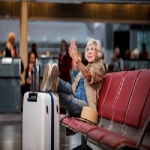Is it Safe to Travel After a Joint Replacement?

Is it Safe to Travel After a Joint Replacement?
It can sometimes be a long haul before finally deciding to proceed with a joint replacement. With the right diagnosis and treatment, you can feel like a brand new person, following a joint replacement surgery. At this point in our lives we understand that every surgery requires a recovery; but when is it safe to get out there and live life again? When is it safe to hop in the car and see what’s out on Route 66, travel to see the kids/grand kids, or fly over the pond to explore exotic land? When is it too soon to get back to traveling?
 When is it safe to get out there and travel?
When is it safe to get out there and travel?
It typically takes a person a few weeks to feel up to traveling, but at six weeks post joint replacement surgery, pain general discomfort becomes less of an issue. Risk of DVTs also lower back to baseline. Swelling and stiffness may be an issue as with any type of surgery.
What should I be most concerned for while traveling?
Other than forgetting your bathing suit, you should be aware of any potential formation of a blood clot in your leg, which is also knows as a Deep Vein Thrombosis (DVT). According to American Association of Hip and Knee Surgery,
, “Several studies have shown that, if appropriate measures are taken, it is safe to travel soon after your joint replacement without an increased risk of developing a blood clot for most patients.”
 So what are these appropriate measures?
So what are these appropriate measures?
If traveling by air- use compression stockings, take Aspirin 325 twice a day while traveling, and perform ankle pumps while in flight to push the fluid up the legs. It’s always advisable to use a cane or walker while traveling to warn fellow travelers to give you space in order to prevent a fall. Also, bringing your trusty handicap placard or using a wheelchair will expedite arrival onto an aircraft.
While in the car or sitting in the aircraft- getting up from your seat or out of the vehicle every hour to walk around for 10 minutes or so is appropriate to discourage DVTs (blood clots). Also be aware of how you are sitting. Your legs should be at a 90 degree angle. Anything more can prevent fluid from returning to the heart properly, causing a backup and increase risk for a possible DVT.
Related Physicians
The providers at Kansas City Bone and Joint Clinic each have their own areas of specialty. Click on the providers below to read more about them.







